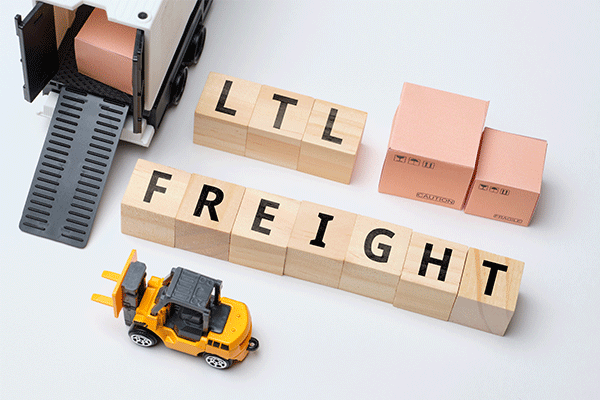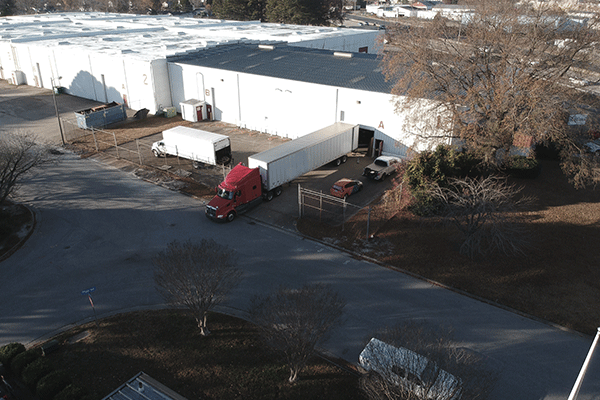
The last itemized list you got from your less-than-truckload transportation provider probably had several surcharges that were included in your final rate. Like many industries, the trucking world is ripe with rich — and oftentimes confusing — jargon.
What are all of these charges that were included in your final rate?
To make the most of your shipping budget, you’ll need to have a strong understanding of the common accessorial charges that pop up when shipping less-than-truckload freight.
Here at ATS, we’ve been operating in the shipping industry since 1955. As such, we understand that the more information you have, the better prepared you’ll be to avoid paying unnecessary LTL charges in the future as you work to maximize your budget.
In this blog, we’ll break down the most common LTL accessorial charges that you’re likely to see when using this method for shipping freight so that you’re better equipped going forward.
The 19 most common less-than-truckload accessorial charges are:
- Appointment-required fees
- Blind shipment charges ($100-$200)
- Detention fees
- Guaranteed shipment charges
- Hand-unload/lift-gate charges ($100-$400)
- Inside pick-up/delivery charges ($100-$600)
- Limited access fees
- Lumper charges
- Marking/tagging fees (less than $100)
- Notification before delivery charges ($50)
- Nonbusiness hours pick-up charges
- Over-dimensional freight charges
- Protect-from-freeze charges ($15-$60)
- Residential pick-up/delivery fees
- Remote access fees
- Re-consignment/diversion fees
- Re-class/re-weight charges
- Sort and segregate charges
- Trade show pick-up fees
Appointment-Required Fees
Some businesses that either have trucks picking up/ dropping off shipments regularly or don’t have workers on hand to load/unload trucks at certain times, need to schedule appointments. This helps them to better handle, monitor and prepare for each trucks’ arrival.
When this is the case, LTL carriers charge a fee to accommodate these requests. The total amount of this surcharge varies from one carrier to the next. That said, the more warning you can give a carrier that you’ll require an appointment, the better.
As such, it's important that if you’re a shipper or receiver who’s impacted by limited shipping windows you let your transportation partner know in advance. Doing so will help to ensure that when your scheduled pick/drop times arrive, your truck will be ready and waiting.
Blind Shipment Charge ($100 - $200)
A blind shipment is a special situation where the third party — who’s in charge of moving the shipment — doesn’t want the shipper to know who the receiver is and vice versa. This is an option for parties who want to keep sensitive information from the other stakeholders in the shipping process.
If you’d like to employ this option for your next shipment, you should expect to pay in the range of $100-$200 to do so.
Detention Fee (Varies by the hour)
If you’ve ever had a driver show up on time and they were forced to wait because your shipment wasn’t ready to go, you’ve likely seen a detention charge. The severity of these charges for LTL shipments depends on the amount of time a trucker is delayed because of a shipper/receiver.
The amount of free time a carrier grants for the loading and unloading process is completely dependent on that LTL carrier and the amount of freight that needs to be loaded.
As a general rule of thumb though, shippers and receivers will be charged a flat rate for every 15 minutes they delay the truck past their allotted time frame. As such, if this applies to your situation, you should expect to pay more for your freight.
Guaranteed Shipment Charges
In some cases, freight carriers will offer “guaranteed” shipments to shippers/receivers. This means that these carriers can ensure that a party’s freight arrives by the specified time on a specified date.
Due to the fragmented nature of LTL shipments, delivery times are all but impossible to guarantee which makes this a highly coveted service. In some cases, if a shipment’s delivery guarantee isn’t met, the stakeholder in charge of paying this fee is let off the hook.
Although this charge varies from one carrier to the next you should expect to pay more money for a guaranteed shipment since LTL carriers will have to shift their scheduling to accommodate such requests.
Hand-Unload Charge/Lift-Gate Charge ($100 - $400)
Sometimes, a truck driver is requested to either hand unload freight from the bed of his truck or to use a lift gate to offload his vehicle. This is typically the case if a shipper/receiver doesn’t work from a loading dock and they don’t have the necessary equipment to properly unload their freight from the truck.
In these situations, LTL carriers — who don’t require their drivers to assist in the unloading process — charge more when they help out.
The price of this service is generally based on the size, weight, class and quantity of the freight in question as well as how much unloading a driver is required to do. The typical cost of these charges ranges from $100 to $400 per shipment.
As such, if your situation calls for lift-gate or hand-unload services make sure to budget accordingly.
Inside Pick-up/Delivery Charge ($100 - $600)
This accessorial charge is applied when a shipper or consignee wants their freight to be picked up at, or delivered to, locations that are not located inside a loading zone that’s accessible by the truck.
This means that when an LTL shipment — on a truck’s arrival — is located floors above a trailer and isn’t actively waiting to be loaded/unloaded, this charge applies. As soon as the driver has to walk into the building to receive/drop off a portion of freight — at the request of a shipper/receiver — that party should expect to pay this surcharge.
Limited Access Fee ($100 - $200 per shipment)
Sometimes, shipments need to be transported to, or picked up from, an area that allows a minimal amount of access to large trucks and trailers. This can include locations like:
- Schools
- Hospitals
- Golf Courses
- Ports
- Piers
- Lodging Facilities (ski resorts)
This is by no means a comprehensive list so you must ask your transportation provider ahead of time whether your locations will be impacted by this charge.
Lumper Fee (Varies)
Lumper fees are seen most commonly in the perishable food industry. Lumper services are third-party unloading services paid above and beyond the cost of transporting the load. Unlike virtually all the other surcharges on this list, this likely won’t be included in your quote upfront because the cost varies based on which lumper service provider is used.
The service used generally isn’t known until it has already been paid for onsite by the consignee and is a pass-through charge, meaning your transportation provider will charge you exactly what they are charged with no “service fee.”
Marking/Tagging Fees (Less than $100)
Whenever a shipper/receiver requests that a carrier alter the markings or tags attached to a piece for freight, this service fee is charged. Although this fee isn’t typically very steep — often less than $100 per shipment — it’s something that can easily be avoided as long as the party responsible is diligent in properly marking their shipment.
Non-Business Hours Pick-up Charge ($100 - $200 per shipment)
Whenever a pickup or delivery is requested between the hours of 8 p.m. and 7 a.m. Monday through Friday — hours that lie outside of the typical business day — this charge applies. Since it’s difficult for LTL carriers to plan out deliveries — especially for exact time frames — they must charge extra to accommodate this shift in schedules.
This charge is also levied if a pickup/delivery falls on a holiday or weekend. These are days where carriers aren’t required to be actively on duty and must be properly motivated to operate. In these instances, the party in charge of paying for the freight will be charged for every hour the trucker spends servicing the pickup/delivery of a shipment. (typically around $100/hour)
Notification Before Delivery ($50)
As the receiver of a shipment, it can be helpful — especially when you want to have all the pieces in place to ensure a smooth offloading process — to know when your shipment is approaching your facility.
Whenever a shipment’s bill of lading specifies that the consignee has requested a phone call or email notification, before the freight’s delivery, this convenience comes at a price. This “notification before delivery” is billed at a flat fee that typically doesn’t exceed $50.

Over-Dimensional Freight Charge (LTL)
When using LTL carriers, the size of a shipment matters greatly. Since these carriers make their money by servicing many different shipments requested by many different parties, maximizing their available trailer space is important. As such, if your freight takes up more space than the average LTL shipment, you’ll need to pay more to move it.
This charge is typically levied in tiers beginning as soon as the freight takes up more than eight feet of trailer space. From here, shippers should expect to pay more money for every 4 feet of LTL trailer space their freight occupies.
Although this charge — like the others — varies from one carrier to another, you should expect to pay no less than $50 more each time your freight’s length carries it from one tier to the next.
Here’s a chart outlining these OD freight tiers:
|
Less Than 8 Feet |
No OD Charge |
|
8 feet - 11 feet, 11 inches |
Initial OD Charge (Around $100) |
|
12 feet - 15 feet, 11 inches |
Increased OD Charge |
|
16 feet - 19 feet, 11 inches |
Higher OD Charge |
|
20 feet and greater |
Highest OD charge |
Protect-From-Freezing Service Charge ($15-$60)
If you’ve ever worked with goods that need to be temperature controlled or would be significantly damaged by prolonged exposure to sub-freezing temperatures, you’ve likely used this service.
“Protect-from-Freezing” service requests — when asked for by a shipper — ensure that the freight in transit avoids freezing at all costs. This means that the LTL carrier will often plan the shipment's route to avoid forecasted cold temperatures. As you may suspect, this service is highly disruptive to carriers and is priced accordingly.
Many carriers across the northern U.S. offer protection from freezing services during the portions of the year that call for it. If you have an LTL shipment that you’re worried about damaging in sub-freezing temperatures, ask your provider about protect-from-freezing services.
Residential Pick-up/Delivery Fees ($100 - $600)
If you need to have your freight picked up at — or delivered to— a private residence, you’ll need to plan for this accessorial charge. Because it’s often inconvenient for a large truck to navigate residential neighborhoods — a process that’s disruptive to their scheduling — carriers are motivated to charge extra to do so.
Although every carrier is different, these charges are calculated based on the weight of the freight in question and the amount of time it takes to reach the destination (see remote access) with a typical range of $100 - $600.
Remote Access Fee (varies by location)
These charges are included in the pricing of an LTL shipment when it needs to be delivered to, or picked up from, a location that’s far outside the typical route serviced by a carrier. These are often locations that have low populations, shoddy economic infrastructure or remote access. These charges vary based on the location of a freight’s starting/ending point and most carriers list these prices based on their zip codes.
Since these are locations that don’t have a lot of capacity needs — to add them to their schedule — LTL carriers need to go out of their way to make these freight shipments work. As such, LTL carriers charge more to do so. If you’re wondering how your freight’s origin and destination will impact its price, make sure to talk to your provider about remote access charges.
Re-consignment/Diversion (Varies)
If you’re a shipper who’s had to change the final delivery destination of a freight shipment after it’s already in transit, you’ve likely seen re-consignment surcharges. These charges, also called diversion fees, pop up when the final destination for the freight in transit needs to be changed from what is represented on the BOL.
Because this action forced the LTL carrier to significantly adjust their scheduling to re-route your shipment, they need to charge shippers to do so. If your shipment has left your facility and you need to change information such as its final destination, the name of the consignee or additional instructions on how the freight should be delivered, expect to pay this charge.
The base rate of re-consignment/diversion charges can be less than $50 but — depending on the amount of adjustment a carrier needs to make — new rates may be applied to these shipments.
Re-class/Re-weight
The National Motor Freight Traffic Association provides guidelines for classifying freight based on:
- Shipment density
- Handling requirements
- Stow-ability
- Liability risk
The combination of these four elements allows for the classification of freight into 18 separate categories for LTL shipments. Often, the higher the classification a shipment has (ranging from 50 to 500) the more money it takes to move it.
Sometimes, one or more of these categories isn’t reported correctly on the shipment’s original bill of lading. Maybe the pallet is larger than expected or the freight weighs more than it should. In these instances, a reclassification or re-weight of the shipment is required to correctly price the load.
Often — even though re-classified freight will cost more than previously quoted if necessary — there’s an additional charge to re-calculate these metrics and adjust the bill of lading accordingly.
As such, you must understand the density and classification of your LTL shipment before your trucking solution’s arrival. This will help to make sure that this charge doesn’t impact your bottom line.
Sort and Segregate Charges
This charge applies when a carrier is required to sort or segregate a shipment in any way necessary to complete the shipment process. This includes, but is not limited to, placing pieces of the shipment on shelves or racks, removing freight from a pallet or transferring freight from one pallet to another.
Any time that the freight has to be handled in a way that impacts an LTL carrier’s ability to stick to their timeline, this charge is applied to the final bill. Once again, the amount of these fees varies greatly depending on what carrier you use and how much time it takes to sort the freight.
Trade Show Pickup Charge (Varies)
If you’re a shipper who needs to have LTL products picked up from a trade-show location, this charge will be applied to your freight. If you’re wondering what your LTL solution will charge for this service, make sure to confer with your provider before pickup.
How to Make the Most of Your LTL Shipping Budget?
Making the most of your LTL freight shipping budget is all about knowledge. The more you know about the intricacies of this shipping service, the better off you’ll be.
Now that you have a better understanding of some of the common accessorial charges that pop up when shipping LTL freight, find out why shipment transit timing is so varied between LTL, PTL and FTL shipments. Doing this will help you as you continue to expand your knowledge on these topics!
If you’d like to find out how ATS can help you move your next shipment, please don’t hesitate to reach out, we’re always ready to assist you in any way we can.





